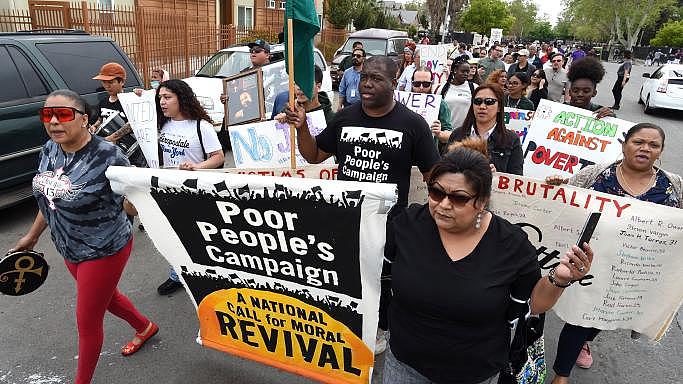Redefining Who Is In Poverty Could Bump Thousands From Medi-Cal

John Walker/The Fresno Bee
California’s push to give everyone access to affordable health insurance could be disrupted by a federal plan to change the standards for poverty, according to analysts.
The Trump administration announced last month that it’s considering changes to the way it sets the federal poverty line — a measure of household income used by the federal government to determine who is eligible for certain government programs and benefits — in an attempt to better measure inflation. New options on the table could raise the annual income thresholds for households to qualify for Medi-Cal, CalFresh and other government programs.
Right now, using the Consumer Price Index for All Urban Consumers, federal officials adjust the poverty line based only on price increases for goods and services. A new measure the administration is considering, the Chained Consumer Price Index for All Urban Consumers, would assume families are changing spending habits in response to inflation.
For example, if the price of apples goes up, this new measure assumes people will buy fewer apples or substitute with something cheaper.
But researcher Ian Eve Perry at the UC Berkeley Center for Labor Research and Education says low-income residents have few options for substitution. They’d still be paying for expensive items and services, including rent and child care, but the new measure would underestimate their cost of living. As a result, they could lose eligibility for some public programs.
Perry’s research estimates that 30,000 children and 30,000 adults would lose Medi-Cal eligibility, and over 1 million Californians with subsidized coverage through Covered California would receive smaller subsidies or lose their subsidies entirely. That’s because increases in their income would surpass increases in the poverty threshold resulting from the new inflation measure.
“The cost of living for low-income people is already kind of underestimated,” Perry said. “These concepts are considering an even lower cost of living — that’s just going to make things worse.”
But Charles Blahous, a senior research analyst at the Mercatus Center at George Mason University, said that both inflation measures actually overestimate the cost of living, and aren’t designed to accommodate regional differences.
“The point of the inflation indexes is to get a measure of general price inflation,” he said, adding that there’s a strong consensus that the “chained” measure is more accurate than what’s currently being used.
Former President Barack Obama proposed making this switch 2013 in an attempt to strike a budget deal. It would have saved the federal government an estimated $130 billion over a decade, according to The Washington Post.
Blahous says past efforts to change federal poverty measures have gotten tangled up in politics, and that it’s a “bad idea to try to achieve policy goals by mismeasuring inflation.”
The Trump administration has made other attempts to use rule changes to shift policy, such as adjusting the criteria for when an immigrant is deemed a public charge, or taxpayer burden, for using government aid, thereby affecting their eligibility for a green card.
Experts say changing the way the poverty level is adjusted could have an especially harsh effect on low-income families in California, where the cost of living in many areas continues to rise rapidly. The latest data from the U.S. Census Bureau show California is tied with two other states for the highest poverty rates in the nation after adjusting for costs such as housing and health care.
Sara Kimberlin, senior policy analyst with the California Budget and Policy Center, says there’s already a mismatch between the federal poverty line and what California families need to make to survive.
According to the center, the average family budget for a single parent of two was nearly $66,000 in 2017, while the official poverty line for a family that size was just $19,749. In the most expensive parts of the state, the cost of basic needs is more than five times the federal poverty line, according to the report.
Kimberlin says it’s not realistic to expect the state to backfill funding to cover families that are bumped from these programs.
“It would not be possible for the state to compensate,” she said. “These are major programs that have major federal funding attached to them.”
The federal Office of Management and Budget is accepting comments on the inflation measures until June 21. Find instructions on how to comment here.
Follow the USC Center for Health Journalism Collaborative series "Uncovered California" here.

